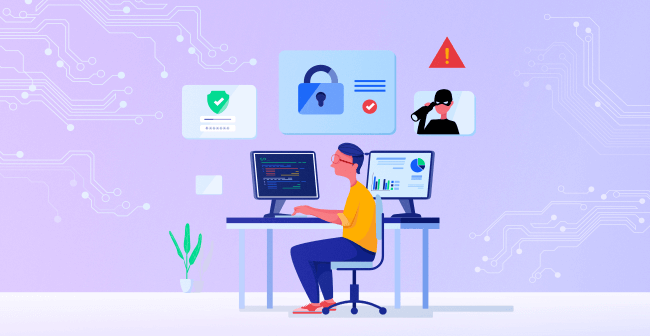Introduction
Are you considering improving or upscaling your organization by transitioning to the cloud? Well, then, it is a wise decision. As companies migrating their data and operations to the cloud continues to grow, complying with security regulations and standards has become paramount. The cloud provides numerous advantages, such as enhanced flexibility, scalability, and cost-effectiveness.
Did you know that over 3 out of 4 enterprises now use at least two cloud providers? In fact, over a third of organizations have more than half of their workloads in the cloud. Additionally, nearly 30% of organizations anticipate increasing this number to 75% of workloads in the cloud within the next year to a year and a half.
However, it also introduces new security challenges. One of the primary concerns for organizations transitioning to the cloud is ensuring compliance and security. With regulations constantly changing and new security threats emerging regularly, it can be overwhelming to determine where to begin.
But don't worry! In this blog post, we'll explore strategies for achieving compliance in the cloud and maintaining robust security measures to safeguard your data and operations. Before we dive into the strategy, let's first understand cloud computing and cloud compliance and their importance.
What is Cloud Computing?
We have utilized the power of cloud computing for over a decade now. For example, we use cloud storage when we access an email attachment from another computer. This technology transforms entire industries, not just benefiting individuals.
For example, banks and financial institutions lead in adopting cloud computing. It has become a real game-changer for them. The use of cloud computing in this sector has skyrocketed due to the ability to offer virtual services through the cloud. With the rise of digital currencies like Bitcoin and online payment services like PayPal, the future of banking lies in the cloud.
Google reports that the global cloud computing market was valued at $371.4 billion in 2020 and is estimated to rise to a staggering $832.1 billion by 2025. That looks amazing!
There are several models of cloud computing services available to suit your needs:
- Infrastructure as a Service (IaaS): Get virtualized computing resources such as storage, networking, and servers delivered as a service. Create your virtual machines (VMs) or install your operating system (OS) and software - the choice is yours.
- Platform as a Service (PaaS): Enjoy a complete environment for developing, testing, and deploying your software applications. Let the PaaS provider manage the underlying infrastructure, operating system, and middleware so you can focus on what you do best.
- Software as a Service (SaaS): Access ready-to-use software applications over the Internet without the hassle of installation, maintenance or updates. From web-based email to CRM and project management software - SaaS has got you covered.
Let's move forward to the most awaited question, "What is Cloud Compliance?"
What is Cloud Compliance?
Cloud compliance ensures that cloud-based systems adhere to the standards and regulations set forth by their customers. IT professionals closely monitor this critical issue for new cloud computing services. However, it's important to note that not all cloud service providers may meet an organization's specific compliance requirements since their offerings can vary.
Non-compliance can result in regulatory fines, legal action, cybersecurity incidents, and damage to reputation. Therefore, compliance is a serious matter that requires a deep understanding.
Organizations must thoroughly understand their cloud provider's offerings and their compliance requirements.
But how can you ensure that your business is compliant? In the next section, we will discuss how to ensure that your organization meets compliance regulations in the cloud.
Understanding Cloud Compliance Regulations and Their Requirements
As cloud computing continues to grow in popularity, compliance regulations have become increasingly important to ensure the security and privacy of data in the cloud. Here is an overview of some of the most popular compliance regulations and their requirements:
1. Payment Card Industry Data Security Standard (PCI DSS): As a merchant using cloud-based services, you must ensure that your environment is properly segmented and access controls are in place to prevent unauthorized access from one customer's environment to another. PCI DSS 4.0 introduces new requirements for securing cloud and serverless workloads. The scope of PCI DSS requirements applies to the card data environment (CDE), which includes system components such as network devices, servers, computing devices, virtual components, cloud components, and software.
Qualified Security Assessors (QSAs) will verify during their audit that your organization only has access to its own cloud-based CDE and cardholder data and cannot access other organizations' cloud-based card data environments. Therefore, ensuring that you configure your cloud environment correctly to meet these requirements is essential.
2. Health Insurance Portability and Accountability Act (HIPAA): If you are a covered entity or business associate using cloud services to store or process electronically protected health information (ePHI), you must ensure that you are compliant with the Health Insurance Portability and Accountability Act (HIPAA). This involves having a written Business Associate Agreement (BAA) with your cloud service provider (CSP) that outlines their responsibilities for HIPAA compliance.
You must also conduct a risk analysis to assess the potential risks and vulnerabilities to the confidentiality, integrity, and availability of ePHI in the cloud environment and implement appropriate safeguards to reduce these risks to a reasonable and appropriate level.
3. General Data Protection Regulation (GDPR): As enterprises embark on their cloud journey, ensuring GDPR compliance should be a top priority. To comply with the GDPR's principles of lawfulness, fairness, transparency, purpose limitation, data minimization, accuracy, storage limitation, integrity and confidentiality (security), and accountability, organizations must adopt a risk-based approach to data protection and implement technical and organizational controls to safeguard personal data against unauthorized access, use, disclosure, destruction or loss.
4. Sarbanes-Oxley Act (SOX): Cloud-based services that handle financial data for publicly traded companies can comply with SOX by implementing controls and processes to ensure the accuracy and reliability of their financial reporting. This includes access controls, data encryption, regular backups, monitoring and incident response procedures, and risk assessments.
By adhering to these standards and undergoing regular SOX audits, cloud-based services can demonstrate their commitment to protecting their customers' financial data and meeting their regulatory obligations.
5. Systems and Organization Controls 2 (SOC 2): Cloud-based services can comply with the five Trust Service Principles and Criteria (TSP) required for SOC 2 reporting by implementing controls and processes to ensure the security, availability, processing integrity, confidentiality, and privacy of their systems and data.
This includes access controls, network and application firewalls, data encryption, regular backups and disaster recovery plans, monitoring and incident response procedures, and regular risk assessments. By adhering to these principles and undergoing regular SOC 2 audits, cloud-based services can demonstrate their commitment to protecting their customers' data and meeting their objectives.
6. International Organization for Standardization 27001 (ISO 27001): To comply with ISO 27001, cloud-based services implement an Information Security Management System (ISMS) that meets the standard's requirements. They implement controls and processes to ensure the confidentiality, integrity, and availability of their information assets.
These measures include access controls, network and application firewalls, data encryption, regular backups and disaster recovery plans, monitoring and incident response procedures, and regular risk assessments. By adhering to these standards and undergoing regular ISO 27001 audits, cloud-based services demonstrate their commitment to protecting their customers' data and meeting their regulatory obligations.
All the frameworks mentioned above have their requirements and apply to different industries and data types. Now, let's move on to the next section, where we will discuss some advanced techniques and strategies for ensuring compliance with cloud security.
Strategies for Ensuring Cloud Compliance with Security
Ensuring compliance in the cloud can be a challenging task for businesses. With numerous regulations to consider and the potential consequences of non-compliance, it can be challenging to determine where to begin and how to ensure compliance. In fact, according to a recent survey, nearly 80% of organizations have experienced cloud security breaches in the past 18 months.
To overcome these challenges and protect their customers' data, businesses can adopt several strategies for cloud security compliance.
Here are some of the key strategies to consider:
1. Perform a Comprehensive Cloud Risk Assessment
Many organizations are planning to move data to the cloud. To do this, organizations must assess potential compliance risks. This process assists you in identifying the types of data you can securely store in the cloud and the ones you should keep on your on-premises servers. With the growing number of cloud security breaches worldwide, conducting a comprehensive risk assessment is more important than ever.
This helps you fulfill your compliance obligations and ensure the confidentiality and integrity of your data. Did you know that at least 73% of companies already use the cloud to serve some of their applications, according to an IDG report? To mitigate potential vulnerabilities, it's essential to conduct a thorough risk assessment. This helps you uncover any security gaps and address them appropriately.
By doing so, you can avoid severe consequences such as regulatory fines, legal action, loss of business, and damage to your reputation.
2. Selecting a Trusted and Secure Cloud Provider
Make sure to choose one with a good reputation for security and compliance. Look for providers with industry certifications, such as SOC 2, PCI DSS, and ISO 27001.
Big Corporations such as Microsoft Azure, Google Cloud, and Amazon Web Services (AWS) are reputable cloud providers that adhere to rigorous security and compliance standards.
Cloud service providers may achieve certifications and attestations such as ISO/IEC 27001, ISO/IEC 27017, ISO/IEC 27018, ISO/IEC 27701, PCI-DSS, HIPAA/HITECH, FedRAMP, and GDPR. The specific certifications obtained depend on the data access policies of each cloud service provider. These certifications help customers satisfy compliance requirements for virtually every regulatory agency globally.
3. Strengthening Cloud Security with Robust Access Controls
A study by Oracle and KPMG found that 72% of organizations view the cloud as more secure than their on-premises solutions. Misconfigured cloud security controls and human error are two significant factors contributing to this surge in cloud data breaches. Gartner predicts that by 2022, 95% of cloud security failures will be due to customers' lapses.
Robust access controls like multi-factor authentication and role-based access controls can reduce the risk of cloud data breaches and protect sensitive data. In addition, a cloud-based access control system can save IT and security teams time.
4. Securing Sensitive Data with Encryption in Transit and at Rest
Encrypting data both in transit and at rest is crucial for protecting sensitive data from unauthorized access. Choosing a cloud provider that offers encryption as a standard feature is important. IBM Cloud Architecture Center emphasizes using encryption and monitoring data activity to verify, and audit data outsourced to the cloud. Data at rest can be protected by encryption, ensuring its safety even if lost or stolen.
5. Maintain Cloud Compliance through Regular Monitoring and Auditing
Regularly auditing your cloud environment can help identify and address compliance risks. This involves tracking access logs, checking security configurations, and conducting vulnerability assessments. It's essential to categorize information assets and have a contract that grants the right to audit the cloud environment and an exit strategy with clear conditions.
In 2021, it took about one week for 30% of organizations to bring their cloud environments into compliance after an audit. In 2019, around 56% of IT professionals believed using cloud resources increased their organization's compliance risk.
6. Invest in Employee Training for Stronger Cloud Security
Training employees on cloud security best practices is vital for protecting sensitive data in the cloud. This includes teaching employees to identify and report security incidents, use strong passwords, and avoid phishing scams. In addition, organizations can reduce their risk of cloud security incidents by providing regular training and implementing technical controls such as multi-factor authentication and access controls.
- For 2022 and 2023, 76 percent of North America and Europe respondents expected their companies to implement security training tools for their employees.
7. Hire a Third-Party Auditor to Evaluate Your Cloud Security
Hiring a third-party auditor to assess your cloud security can be wise. A third-party auditor is an independent entity that evaluates your cloud security measures to ensure they meet industry standards and compliance regulations. They gather evidence through inspection, observation, performance, or analytics and can identify vulnerabilities and potential risks related to cloud services.
Working with a third-party auditor objectively assesses your cloud security measures and helps you identify areas for improvement. It additionally shows your customers and stakeholders that you consider cloud security seriously and are committed to safeguarding their data.
There are several benefits to hiring a third-party auditor for cloud security. These include:
- Objective assessment: A third-party auditor provides an unbiased evaluation of your cloud security measures and helps you identify areas for improvement.
- Compliance: A third-party auditor, with their wealth of experience and expertise, can assist you in ensuring that your cloud security measures meet industry standards and compliance regulations.
- Risk mitigation: A cloud security audit, whether conducted by an internal or external auditor, identifies vulnerabilities and potential risks related to cloud services. This lets you take proactive steps to mitigate those risks and strengthen your overall cloud security posture.
- Customer trust: Working with a third-party auditor demonstrates to your customers and stakeholders that you take cloud security seriously and are committed to protecting their data.
8. Securing the Cloud: The Benefits of the Shift Left Approach
The Shift Left approach initially integrates security into the cloud development and deployment process. This means businesses consider and integrate security into designing, developing, and deploying cloud services and applications. This reduces the effort and cost of addressing security issues later on and improves overall cloud security by reducing the risk of vulnerabilities during development and deployment.
Take control of your cloud security by implementing these strategies and regularly reviewing and updating your measures. Stay ahead of the game and ensure compliance to protect your valuable data in the ever-evolving landscape of cloud computing.
Conclusion
In conclusion, cloud compliance is not just a regulatory requirement - It's an industry best practice that helps protect your business and its sensitive data.
By implementing effective strategies such as performing a comprehensive cloud risk assessment, selecting a trusted and secure cloud provider, strengthening cloud security with robust access controls, encrypting sensitive data in transit and at rest, and adopting the Shift Left approach to integrate security into the cloud development process from the very beginning, you can ensure that your business is secure and compliant.
The benefits of a secure and compliant cloud environment are clear: reduced risk of data breaches and cyber-attacks, improved data protection and privacy, and increased trust from customers and stakeholders. So don't leave your cloud security to chance - take proactive steps to ensure compliance and protect your business.















Leave a Reply